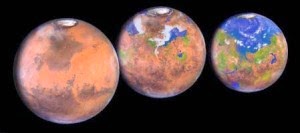 |
| What Mars might look like after centuries of terraformation. Image: NASA/ZME Science |
Topics: Anthropogenic Climate Disruption, Cosmic Connection, Earth, Ecology, Space Exploration, Terraforming
(Okay, somewhat "down-to-Earth"): The first time I read the concept of terraforming ("Earth-shaping") was in the book by Carl Sagan, "The Cosmic Connection" (see chapter 22: "Terraforming the Planets"). In it, he recounted a proposal he made in 1961 to seed algae in Venus' atmosphere to over a period of time cool it enough for human habitation. Biophysicist Robert Haynes coined the "neologism Ecopoiesis, forming the word from the Greek οἶκος, oikos, 'house', and ποίησις, poiesis, 'production'".There was apparently a symposium hosted by NASA in 1979; a book originally printed in 1984: "The Greening of Mars" (ref: Wikipedia). It has a long history in scientific and science fiction thought. Terraforming the planets only makes sense as they are far closer than exoplanets, and we don't have to contest a planet's resources with its inhabitants since as far as we can tell, there aren't any.
Zeroth thought: "Earth-shaping Earth" is redundant and silly. First thought of a geoengineering solution is it requires nothing of the polluters that got us here in the first place. No slight at all to the researchers, just that if you create a fat pill, no one's going to change their diets or continue exercising for increased health: it's the global equivalent of a couch potato, or a public ever more nonchalant about a pending global crisis that we'll "snap our fingers" and fix. Second thought: creating "life forms that clean" could have unintended consequences, as the authors of the Technology Review write up below alludes to. Third: note the photo of Mars above. That's a projection of centuries, not a few months before the first space RVs and suburban settlements. From the aspect of a society that has become entirely too push-button and "hit the reset" oriented, it seems it would be better on our own planet to mitigate anthropogenic climate disruption (a more apt descriptor) with policy and societal change in behaviors. Giving an engineering solution to this important issue without backing legislation or political will is similar in pouring gasoline simultaneously as the fire department attempts to put out a raging blaze.
TECHNOLOGY REVIEW: The inexorable rise of carbon dioxide levels in the atmosphere and the steady increase in global temperatures raise the frightening prospect of significant change in Earth’s climate. Indeed, the evidence seems clear that our climate is altering rapidly.
So scientists and politicians the world over are looking for ways to halt or reverse these changes, a task that is fraught with difficulties in a world hooked on fossil fuels. One option increasingly discussed is terraforming—deliberately altering the environment in a way that cools the planet, perhaps by absorbing carbon dioxide or reflecting sunlight.
To have an impact, these kinds of plans changes must have a global reach require engineering projects of previously unimaginable scale. That’s set bioengineers thinking that there might be an alternative option.
Instead of creating global engineering projects, why not create life forms that do a similar job instead. The big advantage of this approach is that organisms grow naturally and can spread across huge areas of the planet by the ordinary mechanisms of life. Thus the process of terraforming the landscape would occur with minimal human input. What could possibly go wrong?
Plenty. The big fear is that these approach could have unexpected and unintended consequences for the planet. One nightmare scenario is that the organisms might unintentionally trigger feedback mechanisms that accelerate global warming rather than mitigate it. So an important question is how to prevent this scenario.
Physics arXiv: Synthetic circuit designs for Earth terraformation
Ricard Solé, Salva Duran-Nebreda, Raul Montañez
Space.com:
Shell-Worlds: How Humanity Could Terraform Small Planets (Infographic), Karl Tate
Comments